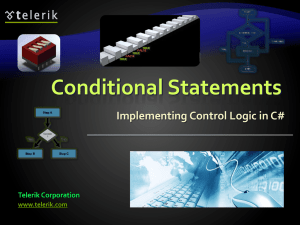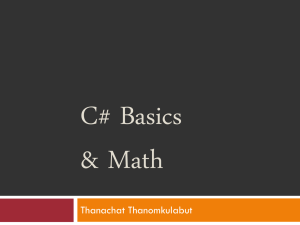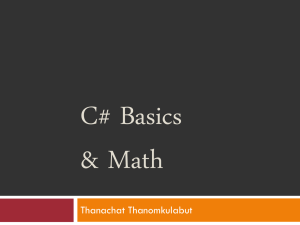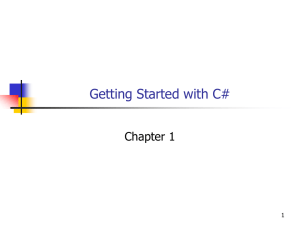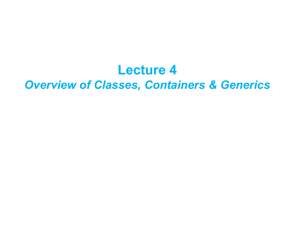Document
advertisement
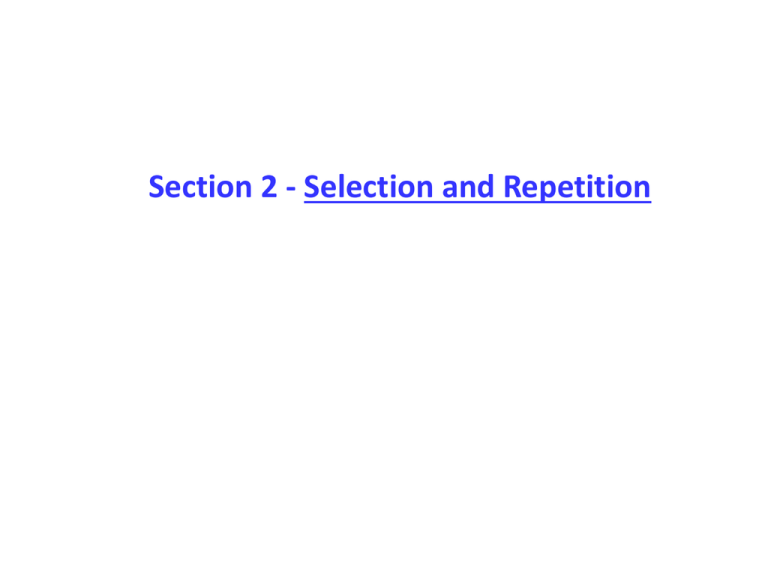
Section 2 - Selection and Repetition
Equality and Relational Operators
Relational Operators
int aValue = 100,
bValue = 1000;
string sValue = “CS158”;
decimal money = 50.22m;
double dValue = 50.22;
char cValue = ‘A’;
Logical Operators
C# Operators
The table on the following slide describes the allowable
operators, their precedence, and associativity.
Left associativity means that operations are evaluated from
left to right.
Right associativity mean all operations occur from right to
left
- Assignment operator, for example - everything to
the right is evaluated before the result is placed into the
variable on the left.
Use round brackets ( ) to impose your own
precedence on expression evaluation
Decision Structures - Selection
Same syntax for C++, C#, and Java
if (Boolean expression)
statement;
• The basic selection statement is the if statement.
• Used to execute or skip a statement or block of
statements { … } depending on a Boolean expression,
• Also have an if … else … construct
Examples
if (x == value100)
{
Console.Write("x is ");
Console.Writeline( x );
}
if (x == value100)
Console.Writeline("x is 100");
else
Console.Writeline("x is not 100");
if (salesForYear > 500000.00)
{
Console.WriteLine( );
Console.WriteLine(“YES...you get a bonus!”);
bonusAmount = 1000.00;
}
if (hoursWorked > 40)
{
payAmount = (hoursWorked – 40) * payRate * 1.5 + payRate * 40;
Console.WriteLine(“You worked {0} hours overtime.”,
hoursWorked – 40);
}
else
payAmount = hoursWorked * payRate;
Switch construct
Same syntax for C++, C#, and Java
switch can only be used to compare an expression with
different constants.
The types of the values a switch statement operates on
can be booleans, integer types, and strings (null is
acceptable as a case label).
Every statement sequence in a case must be terminated
with break
If no case label matches default
switch (expression) {
case constant1:
block of instructions 1
break;
case constant2:
block of instructions 2
break;
.
.
.
default:
default block of instructions
break;
}
You may also include a default choice following all other
choices. If none of the other choices match, then the
default choice is taken and its statements are executed.
Use of the default choice will help catch unforeseen
circumstances and make your programs more reliable.
switch (x)
{
case 5:
Console.Writeline("x is 5");
break;
case 99:
Console.Writeline("x is 99");
break;
default:
Console.Writeline("value of x unknown");
break;
}
switch(country) {
case"Germany":
case"Austria":
case"Switzerland":
language = "German";
break;
case"England":
case"USA":
language = "English";
break;
case null:
Console.WriteLine("no country specified");
break;
default:
Console.WriteLine("don't know language of", country);
break;
}
Loops
Same syntax for C++, C#, and Java
while (Boolean expression)
{statements}
int x – 10;
while ( x > 1 )
{
Console.Writeline("x is ");
Console.Writeline( x );
x--;
}
int sum = 0;
int number = 1;
while (number < 11)
{
sum = sum + number;
number++;
}
Console.WriteLine(“Sum of values ”
+ “1 through 10”
+ “ is ” + sum);
do
{statements}
while (Boolean expression)
int x = 10;
do
{
Console.Write("x is ");
Console.Writeline( x );
x--;
} while (x !=1 );
Loops
Same syntax for C++, C#, and JAVA
for (initialization; condition; in(de)crement)
{statement;}
for (int n=10; n>0; n--)
{
Console.WriteLine( n );
}
Examples
x = 5;
if (x > 0 && x < 10)
count++;
else if (x == -1)
...
else {
...
}
while (x > 0)
{
...
x--;
}
for (int k = 0; k < 10; k++)
{
...
}
foreach Construct
• Specialized foreach loop provided for collections like arrays
– reduces risk of indexing error
– provides read only access
int[] data = { 1, 2, 3, 4, 5 };
int sum = 0;
foreach
foreach (int x in data)
{
sum += x;
}
type value array
foreach statement
For looping over arrays
int[] a = {3, 17, 4, 8, 2, 29};
foreach (int x in a) sum += x; //sum numbers in array
string s = "Hello";
foreach (char ch in s) Console.WriteLine(ch);
Windows Applications Using Loops
• Event-driven model
– Manages the interaction between user and GUI by
handling repetition for you
• Designed with graphical user interface (GUI)
• Predefined class called MessageBox
– Used to display information to users through its Show( )
method
using System;
using System.Text;
using System.Windows.Forms;
public class HelloWorld
{
public static void Main()
{
MessageBox.Show("Hello World!");
}
}
Windows Applications Example
using System;
using System.Windows.Forms;
class SquaredValues
{
static void Main( )
{
int counter = 0;
string result ="";
while (counter < 10)
{
counter++;
result += " \t“+ counter + " \t"
+ Math.Pow(counter, 2) + "\n";
}
MessageBox.Show(result, “1 through 10 and their
squares”);
}
}
Windows Applications
• To use MessageBox class in console application
– Add a reference to System.Windows.Forms
• View > Solutions Explorer
• Right-click on the Reference folder
– Select Add Reference
– Look for and select System.Windows.Forms
– Click OK
– Add using directive to System.Windows.Forms namespace
in program
using System.Windows.Forms;
MessageBox.Show( ) method is overloaded – may be called with
different number of parameters
First parameter – String displayed in window
Second parameter– Caption for Window title bar
Third parameter– Type of dialog button
Fourth parameter– Button type
MessageBox class
MessageBox.Show("Do you want another number ?", “Numbers",
MessageBoxButtons.YesNo, MessageBoxIcon.Question);
MessageBox class (continued)
MessageBox.Show("Do you want another number ?", “Numbers",
MessageBoxButtons.YesNo, MessageBoxIcon.Question);
static void Main()
{
bool moreData = true;
Random number = new Random();
int s = number.next(100);
while (moreData)
{
Console.WriteLIne(s);
if (MessageBox.Show("Do you want another number ?",
“Numbers", MessageBoxButtons.YesNo,
MessageBoxIcon.Question) == DialogResult.No)
// Test to see if No clicked
{
moreData = false;
}
else
{
s = number.Next(100);
}
}
MessageBox.Show( ) Method
2nd
parameter
1st parameter
4th
parameter
3rd
parameter
MessageBox.Show("Do you want another number ?",
“Numbers",
MessageBoxButtons.YesNo, MessageBoxIcon.Question);


